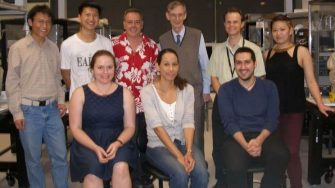
About us
Brain function depends on the co-ordinated electrical and chemical activity of the millions of neurons, glia and synapses which constitute this amazing but complex organ. Our lab investigates the physiological properties of the receptors, channels and transporters that determine this brain activity, and how this changes in diseases. Our lab uses in vivo and in vitro electrophysiological recording techniques to quantify brain function from the circuit level through to the individual cells and molecules, complemented by live cell imaging, cell culture, and histological approaches.
Our current focus is on epilepsy, a disorder of neuronal excitability that affects 1-2% of the world’s population and up to about 400,000 Australians at some time in their life. Temporal lobe epilepsy (TLE) results from a precipitating brain trauma and is resistant to drug treatment. We are investigating the changes in neuronal inhibition in TLE in the hope of developing new therapeutic strategies to mitigate against the seizures that characterise this disease.
Team
Collaborators
- Dr Trevor Lewis (Membrane and Cellular Biophysics, UNSW)
- Professor Peter Barry (Membrane and Cellular Biophysics, UNSW)
- Professor Junichi Nabekura (National Institutes for Physiological Sciences, Japan)
- Translational Neurosciene Facility (TNF, UNSW)
- Dr Robin Witt (GABAther, Sweden)
Students
- Ashor Khoshaba (PhD) Imaging KCC2 function using BCECF
- Dennis Cheung (PhD) Impact of manipulating KCC2 function on seizure activity in vivo and in vitro
- Jasneet Parmar (PhD, cosupervision with Prof Housley, TNF) - Role of TRPC3 channels in cerebellar excitoxicity


